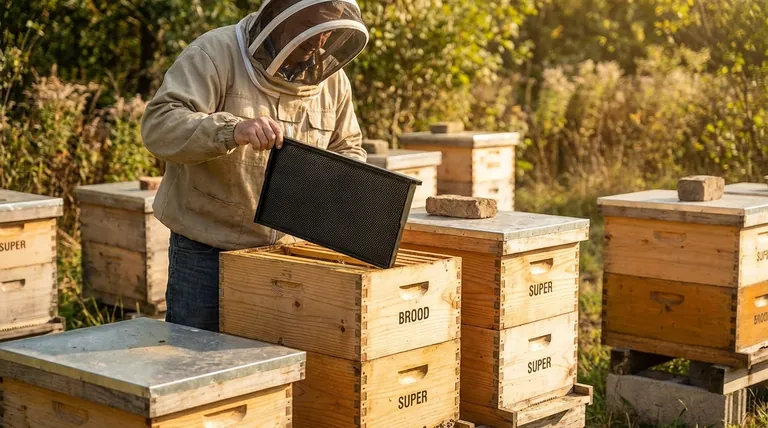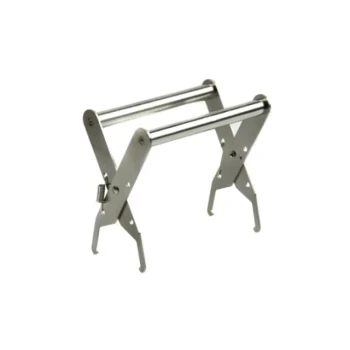The number of frames in a hive is not a single number but depends on the type and configuration of the hive. The most common beehive, the Langstroth, is designed to hold either eight or ten frames within each individual box. The total number of frames is the sum of the frames in all the stacked boxes that make up the complete hive.
A beehive is a modular system of stackable boxes, not a single unit. The critical decision is choosing between an 8-frame or 10-frame system, as this determines the frame count per box and influences the weight and capacity of your hive.

The Core Concept: Frames Per Box
Understanding the number of frames begins with understanding the purpose of the individual box, often called a "hive body" or "super."
What is a Hive Frame?
A hive frame is a simple rectangular structure, typically made of wood or plastic, designed to hold a sheet of foundation. Bees build their honeycomb within this frame, using it for raising brood (young bees) and storing honey.
This design is the cornerstone of modern beekeeping. The ability to remove individual frames allows a beekeeper to inspect the colony's health and harvest honey without destroying the comb.
The Langstroth Standard: 8 vs. 10 Frames
The vast majority of beekeepers use the Langstroth hive. When purchasing equipment, you must choose between two standard widths for your boxes:
- 10-Frame Hives: The traditional standard, offering more space per box.
- 8-Frame Hives: A more modern, increasingly popular option that is lighter and easier to handle.
All the boxes and components you use for a single hive must match this initial choice. You cannot mix 8-frame and 10-frame boxes in the same stack.
A Hive is a Stack, Not a Single Box
A functional beehive consists of multiple boxes stacked on top of one another. The colony's needs change throughout the year, and the beekeeper adds or removes boxes to accommodate this.
Brood Boxes and Honey Supers
The stack is typically divided into two sections. The bottom boxes, known as brood boxes, are where the queen lays her eggs and the colony raises its young. The boxes on top, called honey supers, are where the bees store surplus honey.
Calculating Your Total Frame Count
The total number of frames in your hive is the number of boxes multiplied by the frames per box. For example, a common beginner setup might consist of two deep brood boxes and two medium honey supers.
- In a 10-frame system, this hive would contain 40 frames (4 boxes x 10 frames).
- In an 8-frame system, the same configuration would contain 32 frames (4 boxes x 8 frames).
Understanding the Trade-offs: 8-Frame vs. 10-Frame
Your choice between an 8-frame and 10-frame system has significant practical consequences. This decision is far more important than the total number of frames in the hive at any given moment.
The Case for 10-Frame Hives
The 10-frame hive is the long-standing industry standard. Its main advantage is capacity. Each box holds more bees, more brood, and more honey than its 8-frame counterpart. This can lead to larger honey harvests with fewer total boxes.
The Case for 8-Frame Hives
The primary advantage of the 8-frame hive is weight. A deep 10-frame box filled with honey can weigh over 80 pounds (36 kg), making it difficult for many people to lift safely. A full 8-frame box is significantly lighter and more manageable, reducing physical strain. This is a critical consideration for any beekeeper.
Making the Right Choice for Your Goal
The "correct" system is the one that best aligns with your physical abilities and beekeeping objectives.
- If your primary focus is maximizing production and you are comfortable with heavy lifting: The 10-frame system is the traditional and most productive choice per box.
- If your primary focus is ease of handling and minimizing physical strain: The 8-frame system is a superior choice that makes hive inspections much more manageable.
Ultimately, choosing your hive system wisely is the first step toward successfully and enjoyably managing your own colony.
Summary Table:
| Hive System | Frames per Box | Key Advantage | Ideal For |
|---|---|---|---|
| 10-Frame | 10 | Maximum capacity per box | Maximizing honey production, commercial apiaries |
| 8-Frame | 8 | Lighter weight, easier handling | Beekeepers prioritizing ease of use, reduced physical strain |
Optimize Your Beekeeping Operation with the Right Equipment
As a commercial beekeeper or equipment distributor, choosing the correct hive system is critical for efficiency and productivity. HONESTBEE specializes in supplying high-quality, durable 8-frame and 10-frame Langstroth hive components and beekeeping supplies through our wholesale-focused operations. We provide the reliable equipment you need to build a scalable, manageable apiary.
Let us help you equip your operation for success. Contact our wholesale team today to discuss your specific needs and receive a customized quote.
Visual Guide

Related Products
- Plastic Bee Frame Beekeeping Hive Frames for Wholesale
- Professional In-Hive Bee Feeder HONESTBEE Frame for Beekeeping
- Assembled Wooden Bee Frames with Beeswax Foundation Ready to Use by HONESTBEE
- Plastic Honey Comb Frames Cassette Box for Honey
- Heart-Shaped Comb Honey Frame and Honeycomb Cassette
People Also Ask
- What are the differences between wooden and plastic frames in beehives? Choose the Best for Your Apiary
- Are plastic frames good? Boost Apiary Efficiency with Durable, Pest-Resistant Frames
- What is the role of oxalic acid in plants? A Key to Plant Defense and Internal Regulation
- What are the main types of frames available for beehives? Wood vs. Plastic for Your Apiary
- Are plastic bee hive frames good? A Guide to Modern Durability vs. Natural Appeal



















